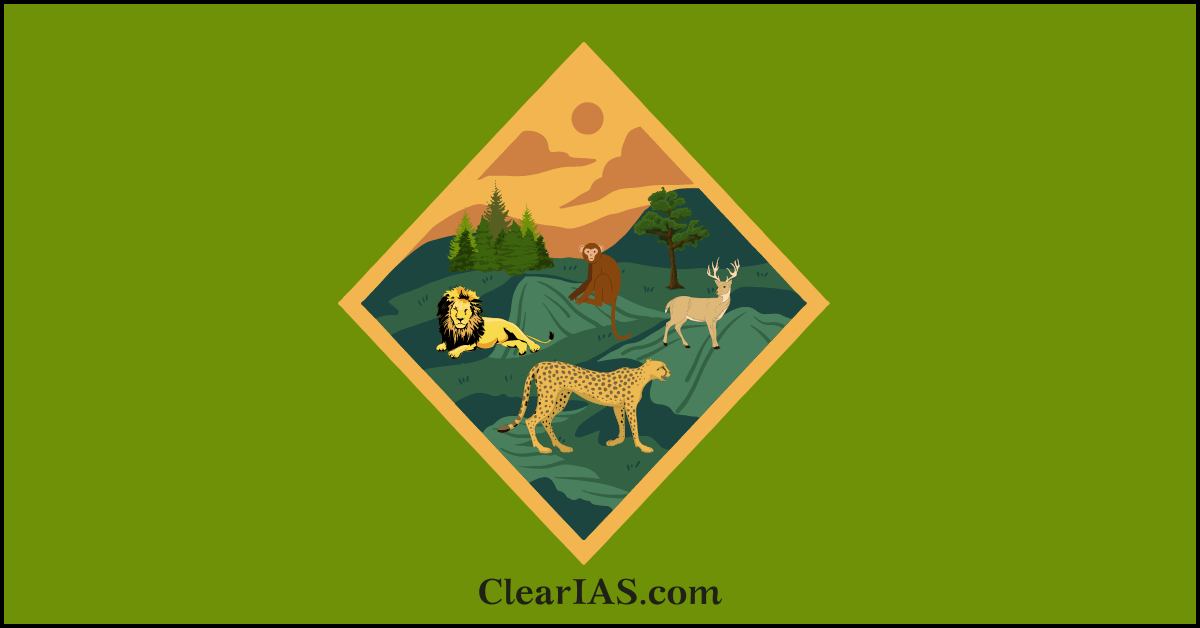 Why Kuno National Park is suitable for Cheetah reintroduction? What are the fauna present in Kuno National Park?Read below to know more about Kuno National Park and other national parks in Madhya Pradesh.
Why Kuno National Park is suitable for Cheetah reintroduction? What are the fauna present in Kuno National Park?Read below to know more about Kuno National Park and other national parks in Madhya Pradesh.
India and Namibia signed a Memorandum of Understanding (MoU) recently to reintroduce the African Cheetah in India.
The Union government has been attempting to reintroduce cheetahs in India since the 1960s and the 1970s.
The Asiatic cheetah, a highly endangered species that only exists in Iran, was officially declared extinct in India in 1952. Although there were documented reports of cheetah sightings in India in 1947, Maharaja Ramanuj Pratap Singh Deo of Surguja state shot the three remaining males in what is now Guru Ghasidas National Park in Chhattisgarh.
Kuno National Park
- Kuno National Park is a national park in the Sheopur district of MP established in 1981 as a wildlife sanctuary. In 2018, it was given the status of a national park. It is part of the Khathiar-Gir dry deciduous forests.
- Kuno National Park has spread over an area of 748.76 sq. km.
- One of the main tributaries of the Chambal River, the Kuno River, cuts across the whole length of the National Park division.
- Wildlife Institute of India and Wildlife Trust of India had shortlisted Palpur-Kuno park as a habitat for Cheetahs and Asiatic lions.
- Cheetahs which once roamed in the northern plains of India became extinct in India in 1948.
- The Kuno has the potential to carry populations of all four of India’s big cats. The tiger, the leopard, the Asiatic lion, and also the cheetah all four of which have coexisted within the same habitats. Historically before they were exhausted by overhunting and habitat destruction.
- Currently, the leopard and striped hyena are the only larger carnivores within the Kuno National Park, the single lone tiger T-38 having returned to Ranthambore earlier this year (2021).
- KunoPalpur Wildlife Sanctuary is underway to become India’s second home for the Asiatic lion.
What are the fauna present in Kuno National Park?
- Kuno National Park is currently home to Indian wolves, jackals, leopards, langur monkeys, blue-bull, chinkara, and spotted deer.
- The other Wildlife of Kuno National Park is
- Chital, Sambar, Nilgai, Wild pig, Chinkara, Chousingha, or Four-horned antelope.
- Blackbuck, Southern plains grey langur, Indian crested porcupine, and Indian hare.
- Carnivores include
- Leopard, Sloth bear, Striped hyena, Gray wolf, Golden jackal, Indian fox, and Ratel.
- One male Panthera tigris (Tiger) which has migrated from Ranthambhore Tiger Reserve has now returned.
- Small carnivores such as
- Jungle cat, Indian grey mongoose,
- Ruddy mongooses and Small Asian mongooses are found here.
- The gharial is also sighted in the Kuno River.
- In Kuno National Park, chital is the most abundant prey for carnivorous species.
Why Kuno is Suitable for Cheetah reintroduction Plan?
- The Kuno National Park has diverse habitats conducive for lions and cheetahs constituted by
- Open woodlands,
- Savanna,
- Dry deciduous forests.
- Evergreen riverine forests.
- Forest grass species are common in valley habitats while plateau tops had shorter grasses.
- Kuno National Park is part of a large forested landscape constituted by the Sheopur-Shivpuri forests covering an area of -6800 sq. km.
- The lone tiger returned to Ranthambore early this year. Currently, the leopard and striped hyena as the only larger carnivores present in the National Park (2021).
- In the degraded forests outside the National Park, the presence of wolves is also reported.
- The density of leopards in Kuno National Park is 8.9 per 100 sq. km.
Anthropogenic activities in Kuno National Park
- The predominant communities in the area are Sahariyas, Gujjars, and Yadavs.
- Agriculture, pastoralism, occasional work, and the gathering of non-timber forest products are the main sources of income for inhabitants.
- People of Moghiya and Bhil tribes, well-known for their hunting abilities. They reside in low numbers amongst the fringe villages.
- The other communities are Dhakad, Jatav, and Thakur, which own some of the largest agricultural holdings.
Wildlife Sanctuary in Madhya Pradesh
A sanctuary is a protected area that is reserved for the conservation of only animal and human activities.
Madhya Pradesh has 10 National Parks and 25 Wildlife Sanctuaries and 6 Tiger Reserves as Protected Areas, which constitute 3.51% of the total geographic area.
Boundaries of sanctuaries are not well defined and controlled biotic interference is permitted.
Let’s look at the national park in Madhya Pradesh one by one.
Kanha national park
- It is also a tiger reserve.
- situated in the Maikal range of Satpuras.
- Located in Central India, it experiences a tropical monsoonal climate.
Major Species found
- The state animal of Madhya Pradesh, the Hard Ground Barasingha, is found exclusively in the Kanha Tiger Reserve.
- Major species found are hard ground Barasingha, Tiger, Leopard, Dhole, Bear, Gaur, Indian Python, etc.
- The lush green forests of Kanha are composed majorly of Sal (Shorea Robusta) and other mixed forest trees.
Kuno National Park
- Kuno National Park is spread over an area of 748.76 sq. km.
- It is located in the Sheopur district of Madhya Pradesh.
- The Kuno River, one of the major tributaries of the Chambal River, flows through its entire length, bisecting the National Park division.
- Kuno park is known for its leopard, jackal, and Chinkara.
- The Wildlife Institute of India and the Wildlife Trust of India had shortlisted Palpur-Kuno park as a habitat for cheetahs and Asiatic lions.
- The cheetah that once roamed in India’s northern plains became extinct in India in 1948.
- Plans to reintroduce cheetahs in Kuno National Park from South Africa are underway.
- The Kuno can carry populations of all four of India’s big cats, the tiger, the leopard, the Asiatic lion, and the cheetah, all four of which had coexisted within the same habitats historically before they were exhausted thanks to overhunting and habitat destruction.
- The leopard and striped hyena are the only larger carnivores within the Kuno National Park, with the single lone tiger T-38 returning to Ranthambore earlier this year (2021).
Panna national park
- It is located in the Vindhya Hills in northern Madhya Pradesh.
- This land is full of plateaus and gorges.
- The Ken River flows through this terrain.
- Panna national park is bounded north by the Teak forest and east by the Teak-Kardhai forest.
- Vindhyas hill runs from North-East to South-West direction through Panna national park.
Major Species Found
- Tiger, leopard, hyaena, wild dog, sloth bear, white-necked stork, chital, chowsingha, sambar-the largest of Indian deer, Blue Bull, and Chinkara, five species of vultures
- In regions where the Vindhyan soils are shallow, dry climates are typical. Dry and warm temperatures result from the interaction of these two elements. Since plants require both water and nutrients to thrive properly, this might be challenging for them. Due to the dry weather, fires can start more easily, causing harm to the local vegetation and difficulties for residents.
- Teak and dry mixed forest: The dominant vegetation is Dry Deciduous forest with tall grasses and thorny woodlands.
satpura national park
- Satpura National Park is located to the south of the river Narmada.
- It is also a tiger reserve.
- The Satpura tiger reserve was the first biosphere reserve in Madhya Pradesh and was declared in 1999.
- The Satpura National Park is considered the northern extremity of the Western Ghats.
- The Satpura National Park is an essential habitat for the Indian tiger.
Major species found
- The Indian tiger, giant squirrel, Indian skimmer, leaf-nosed bat, hornbill, and the Madhya Pradesh state bird flycatcher (doodhraj)
- It is located on the Pachmarhi plateau, which consists of dense teak forest and sal forest.
Bandhavgarh national park
- It is located in the eastern Satpura hill ranges.
- The Bandhavgarh Fort is located inside the Bandhavgarh National Park.
- Mythologically, the name Bandhavgarh means “bandhav” = brother and “Garh” = fort. This fort was built and given to Lakshman by Lord Ram to keep an eye on Sri Lanka.
- Hills, valleys, marshes, and meadows form a diverse topography in Bandhavgarh National Park.
Major species found
- The density of tigers in Bandhavgarh national park is one of the highest in India.
- The park also has a high population of leopards.
- The tigress, Sita, which was once featured in the famous National Geographic magazine, is also found in the Bandhavgarh national park.
- Bandhavgarh national park has listed 34 species of mammals, 260 species of birds, and 70 species of butterflies.
Sanjay national park
- It is also known as the Sanjay-Dubri National Park.
- Mohan, the world’s most famous white tiger, was found here. He was later bred to the tigress Radha, and most white tigers present around the globe now are their progeny only.
- Sanjay national park was carved into two when Chhattisgarh came into existence in 2000. The area which went to the Chhattisgarh administration is now known as the Guru Ghasidas National Park.
Major species found
- Tigers, along with hundreds of other species.
- Sal forest forms a corridor between Bandhavgarh and Palamu tiger reserve, and animals such as elephants use this corridor for their movement from one park to the other.
Madhav national park
- It is situated in the central highlands of India, intersecting with the upper parts of the Vindhya hills.
- It is interspersed with valleys, hills, plateaus, lakes, and forest ecosystems.
- Sakhya Sagar and Madhav Sagar are the two crucial lakes in the national park.
- Sakhya Sagar lake has an abundant population of marsh crocodiles.
Major species found
- Nilgai, Chinkara, Chowsingha, Sambhar, cheetal, barking deer.
- Leopards, jackals, wild dogs, wild pigs, wolfs, marsh crocodiles, turtles, etc.
- Tropical dry deciduous mixed forest and dry thorn forest. The Kardhai tree is the most abundant species found.
Pench national park
- The Pench National Park is mentioned in famous natural history books such as Ain-i-Akbari.
- Rudyard Kipling’s famous book, “Jungle Book,” is based on the Pench National Park and its surrounding areas.
Major species found
- Three types of forest are found in Pench National Park.
- Tropical wet deciduous forest
- Tropical dry deciduous teak forest
- Tropical dry deciduous mixed forest.
- Teak, mahua, palash, plum, tendu, moyan, sajja, etc.
- Tiger, leopard, jackal, fox, wolf, Gaur, nilgai, Sambhar, chital, Chinkara, wild dogs,
- Various migratory birds also found shelter in Pench National Park, such as Pintail, ruddy shelduck, whistling teal, etc.
Van Vihar national park
- Van Vihar is Located in the capital city of Madhya Pradesh, Bhopal.
- Developed and managed by a modern zoological park, following the guidelines of the central zoo authority.
- The Van Vihar National Park has a road passing through it, allowing easy passage for visitors.
Fossils national park
- This national park is famous for its fossil remains.
- Plants in fossil form dated 40–150 million years ago exist in the park.
- It is situated in the Mandla district of MP.
To know more about the Cheetah reintroduction project click here. Also, read reintroduction of Extinct species and click here.
Article Written by: Remya






Leave a Reply